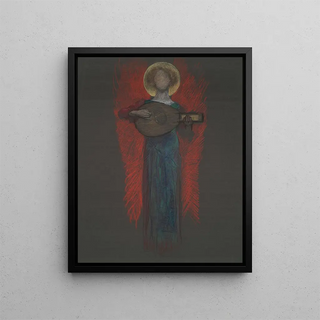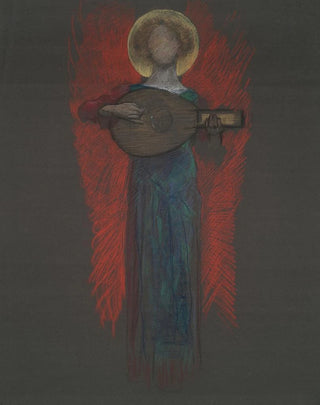Art print | Study Angel with musical instrument - Edwin Austin Abbey


View from behind

Frame (optional)
In the vast panorama of art history, some works manage to transcend their era to touch the soul and mind of future generations. "Angel of Study with Musical Instrument" by Edwin Austin Abbey is one of those creations that captivate with their depth and delicacy. This painting, both mystical and evocative, invites the viewer to immerse themselves in a universe where beauty and harmony intertwine. Contemplating this piece, one feels a connection to a world of ideas and emotions that resonate with our own human experience. Abbey, through his angel, reminds us that music and art are universal languages, capable of transcending the barriers of time and space.
Style and uniqueness of the work
Edwin Austin Abbey's style is characterized by finesse and attention to detail that make each piece a meticulous exploration of light and color. In "Angel of Study with Musical Instrument," the artist employs a subtle palette, where soft and warm tones harmonize to create an almost dreamlike atmosphere. The angel, the central figure of the work, is depicted with an ethereal grace, its delicate posture and contemplative expression evoking profound serenity. The musical instrument it holds, a symbol of harmony, seems to vibrate with a silent melody, inviting the listener to an invisible symphony. This work stands out for its ability to capture a suspended moment, where time appears to stop, giving way to contemplation and reflection.
The artist and his influence
Edwin Austin Abbey, born in 1852, is an artist whose work was deeply influenced by the Pre-Raphaelite movement and symbolism. His career, marked by travels across Europe, allowed him to absorb various artistic influences while developing a personal style unique to him. Abbey mastered the art of blending tradition and innovation, creating works that speak both of history and imagination. His approach to genre painting and the depiction of mythological and religious figures has left a lasting imprint on his contemporaries. "Angel of Study

Matte finish

View from behind

Frame (optional)
In the vast panorama of art history, some works manage to transcend their era to touch the soul and mind of future generations. "Angel of Study with Musical Instrument" by Edwin Austin Abbey is one of those creations that captivate with their depth and delicacy. This painting, both mystical and evocative, invites the viewer to immerse themselves in a universe where beauty and harmony intertwine. Contemplating this piece, one feels a connection to a world of ideas and emotions that resonate with our own human experience. Abbey, through his angel, reminds us that music and art are universal languages, capable of transcending the barriers of time and space.
Style and uniqueness of the work
Edwin Austin Abbey's style is characterized by finesse and attention to detail that make each piece a meticulous exploration of light and color. In "Angel of Study with Musical Instrument," the artist employs a subtle palette, where soft and warm tones harmonize to create an almost dreamlike atmosphere. The angel, the central figure of the work, is depicted with an ethereal grace, its delicate posture and contemplative expression evoking profound serenity. The musical instrument it holds, a symbol of harmony, seems to vibrate with a silent melody, inviting the listener to an invisible symphony. This work stands out for its ability to capture a suspended moment, where time appears to stop, giving way to contemplation and reflection.
The artist and his influence
Edwin Austin Abbey, born in 1852, is an artist whose work was deeply influenced by the Pre-Raphaelite movement and symbolism. His career, marked by travels across Europe, allowed him to absorb various artistic influences while developing a personal style unique to him. Abbey mastered the art of blending tradition and innovation, creating works that speak both of history and imagination. His approach to genre painting and the depiction of mythological and religious figures has left a lasting imprint on his contemporaries. "Angel of Study






